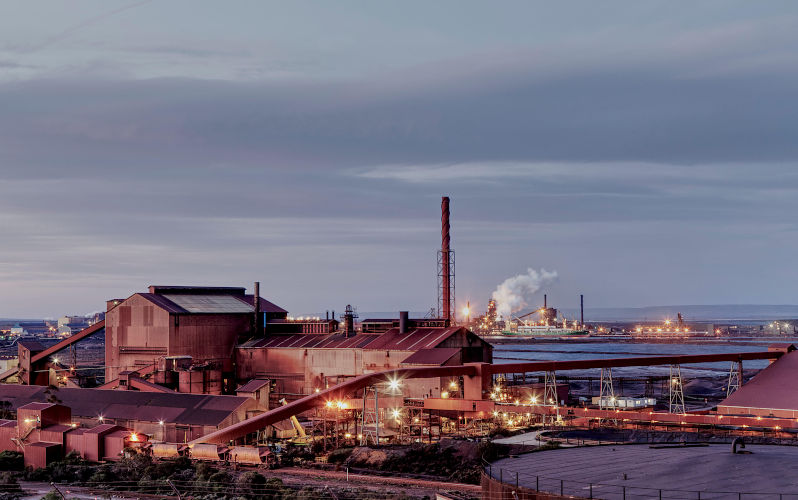The Albanese government’s decision to partner with South Australia to save the Whyalla Steelworks is one of profound significance for Australia’s national security. The governments’ vision — to turn Whyalla into a pioneering green iron and steel facility and capture global first-mover advantage — is hugely ambitious. Done right it has the potential to boost Australia’s economic, energy, environmental, social and military security simultaneously. This could be a game-changer for Australia’s sovereign industrial capability and future export competitiveness in an increasingly uncertain geostrategic environment.
In this context, it is positive that Opposition Leader Peter Dutton has lent his support to the government’s intervention. This might indicate that the national security-enhancing potential of Whyalla is understood across the political spectrum. It certainly shows that saving Whyalla is seen as a political winner. This too is a welcome development, as bipartisan consensus on national security issues has arguably never been more important.
While crucial for national security however, the government’s ambitious Whyalla vision also involves significant risks – not least for Australian taxpayers. So how are these risks best mitigated?
Managing the risks of government intervention
Key to success of the government’s Whyalla vision is understanding the challenges that have stalled green iron and steel projects across the globe, and that contributed to Whyalla’s woes under its previous owner, who professed green iron and steel ambitions, but lacked the financial capacity to deliver.
While producing green iron and steel is technologically advanced, technology is not the key barrier to the emergence of a viable green iron and steel industry in Australia (and globally). Rather, as we have argued elsewhere, the key barrier is the lack of guaranteed demand for green iron and steel at viable prices. This lack of demand scares off private investors because they perceive it as too expensive and risky.
For this reason, a demand-side intervention is essential to attract a new buyer, support the transition to green steel production, and ensure Australia’s sovereign capability in low-emission steel manufacturing.
Reframing government support for Whyalla: From direct bailout to market-based offtake
The Commonwealth and South Australian Governments have pledged $2.4 billion in support for modernisation of Whyalla, including a renewables powered new electric arc furnace. Beyond directly funding plant upgrades, a far more effective and less financially risky approach would be to use a portion of this funding to provide long-term offtake agreements for green steel.
An offtake approach would have three key benefits. First, it would allow a new buyer to decide which assets to acquire and what technology to deploy to meet contracted demand.
Second, it would de-risk private investment by providing certainty of revenue for the green iron or steel they produce.
Third, it would encourage innovation, as investors and operators will optimise their technology choices to deliver green steel most efficiently.
But who would issue these offtake agreements?
Here, the role of a government-owned Clean Commodity Trading Company takes centre stage.
How a Clean Commodity Trading Company (CCTC) works
The CCTC would be a government-backed entity. It would contract for clean commodities like green steel from Whyalla (and other future Australian producers) and then resell it into domestic and international markets.
While the Australian Government could go it alone, the CCTC would preferably be structured as a tri-national partnership between Australia, Japan, and South Korea, with each country contributing financial backing and market access. Japan and South Korea, both major steel supply chain importers, have strong industrial needs for green steel, making them ideal partners.
The primary function of the CCTC would be to:
- Contract for the supply of clean commodities (such as green iron and steel, aluminum, and hydrogen) from producers.
- Aggregate and create demand by selling these commodities to various buyers, including governments, infrastructure developers, and industrial customers.
- Provide market stability by ensuring a price floor that enables investment in new low-emission production capacity.
- Monetise Clean Commodity credits. Upon purchasing “clean commodities” like green iron, the CCTC would de-couple the physical commodities from their environmental attributes to create clean commodity credits. The CTCC could then sell the physical commodities in conventional markets without a “green premium”, and trade clean commodity credit elsewhere. This would address growing demand for emissions reductions in both regulatory and voluntary frameworks. As Europe’s Carbon Border Adjustment Mechanism takes effect, demand for clean commodities in key markets like East Asia will increase, particularly as manufacturers seek compliant, lower-emissions inputs.
- Help facilitate the standardisation and harmonisation of carbon accounting frameworks. Building towards a regulated, progressively rising price on carbon in international trade to value embodied decarbonisation is heavily dependent on the interoperability of monitoring, reporting and verification of embedded emissions in traded commodities. This includes commonly agreed upon emissions intensity calculations, low-emission commodity definitions and independent verification translating to uniform determinations of the volume of commodity carbon credits issues to producers. The creation of a trilateral CCTC between Australia, Japan and South Korea would facilitate the standardisation and harmonisation of carbon accounting frameworks in the respective national green taxonomies in the short- to medium-term. The standardisation would therefore allow clean commodity credits to be traded within the national compliance carbon markets of CCTC members, deepening liquidity in the respective domestic carbon markets and thus accelerating the reduction in emissions caps and baseline intensities.
Proposed CCTC intervention for Whyalla Steelworks
We envisage a successful CTCC intervention for Whyalla would involve four key steps.
Step 1: Reallocate the $2.4 billion into an offtake mechanism
Rather than spending the full $2.4 billion on creditor and worker support, plus direct subsidies and capital investments, a significant portion should be used to fund long-term green steel offtake agreements. The CCTC would enter into a 15-20 year offtake contract with the new owner of Whyalla Steelworks, guaranteeing a minimum price and volume for green iron and steel production.
Step 2: Attracting a new buyer with market certainty
By securing an offtake contract, the new owner of Whyalla could confidently invest in the best available low-carbon steelmaking technology, whether that be Electric Arc Furnaces powered by renewables, Direct Reduced Iron with green hydrogen, or a hybrid combination tailored to their industrial needs. This removes government intervention in asset selection, allowing market-driven technology decisions.
Step 3: CCTC’s market creation role
CCTC would act as an aggregator and market maker, purchasing green steel from Whyalla and then selling it to:
- Government infrastructure projects (e.g., roads, bridges, rail, and renewable energy installations).
- Construction and property developers needing low-emissions materials.
- Automotive and industrial manufacturers transitioning to lower-carbon supply chains.
- Japanese and Korean steel customers requiring CBAM-compliant steel for export to the EU and other regulated markets.
Step 4: Monetising Clean Commodity Credits
Green steel produced under CCTC contracts would generate tradeable Clean Commodity Credits, which could be:
- Sold to companies looking to offset emissions in their supply chains.
- Used by governments to meet climate targets and support carbon neutrality commitments.
- Traded in emerging international carbon markets, creating additional revenue streams.
The national security benefits of applying the CCTC model to the Whyalla Steelworks
The Commonwealth Government has the opportunity to respond to the crisis at Whyalla with a sophisticated green energy statecraft. Green energy statecraft involves seizing the green energy transition as an opportunity to advance a comprehensive national security enhancing agenda – one that boosts energy, economic, environmental, social and military security simultaneously. By applying a CTCC model to its Whyalla intervention, the government could help to address Australia’s comprehensive national security challenges in one hit.
Economic security: A CCTC approach would help:
- Provide a long-term demand signal that enables a new owner to invest with confidence.
- Ensure that Australia retains a sovereign steelmaking capability while creating new jobs in clean manufacturing.
- Stimulate a high-value export industry, supplying premium green steel to Japan and Korea.
Energy security: A CCTC approach would help:
- Reduce Australia’s dependence on imported steel, securing local supply chains.
- Align with the national transition to renewables, integrating green hydrogen and clean electricity into our domestic industrial production.
Environmental security: A CCTC approach would help:
- Enable a deep permanent reduction in steelmaking emissions, helping Australia achieve its 2050 net-zero targets.
- Support global climate objectives, as green steel is essential for decarbonising heavy industry.
Geostrategic security: A CCTC approach would help:
- Position Australia as a leading exporter of green steel, securing long-term strategic relationships with Japan and South Korea.
- Whyalla compete in a world increasingly shaped by carbon tariffs, such as the EU CBAM (Carbon Border Adjustment Mechanism), and encouraging development of an Asian CBAM.
- Reduce reliance on Chinese-controlled steel supply chains, strengthening Australia’s industrial sovereignty.
Social and political security: A CCTC approach would help:
- Leverage the skilled steel workforce in South Australia by providing a viable future for Whyalla.
- Support regional communities and sustain the high-value industrial workforce.
- Demonstrate government leadership in strategic techno-industrial governance, securing bipartisan political backing.
In sum, by redirecting government support from direct capital grants to offtake guarantees, CCTC can provide a government-led but market-based solution to Whyalla’s crisis that has a significant national security-multiplier effect.
A CTCC approach would: ensure a new buyer has confidence to invest in the best green steel technology; create a long-term market for Australian green steel; and strengthen Australia’s industrial base while integrating with international markets.
With CCTC acting as the contracting counter-party, Whyalla’s green steel will have a guaranteed demand, enabling large-scale decarbonisation. It will be sold to domestic infrastructure and industrial projects, accelerating the green transition. And it will be positioned for premium exports to Japan, South Korea, and CBAM-regulated markets.
The CTCC solution represents a sophisticated statecraft approach that cleverly mobilises market-based solutions to bolster national security, comprehensively conceived. It offers the most effective and sustainable path forward for Whyalla Steelworks, Australian industry, and our trading partners in the clean economy.
Pearls and Irritations recommends:
Urgent case for statecraft on green iron and steel to secure Australia’s future prosperity

